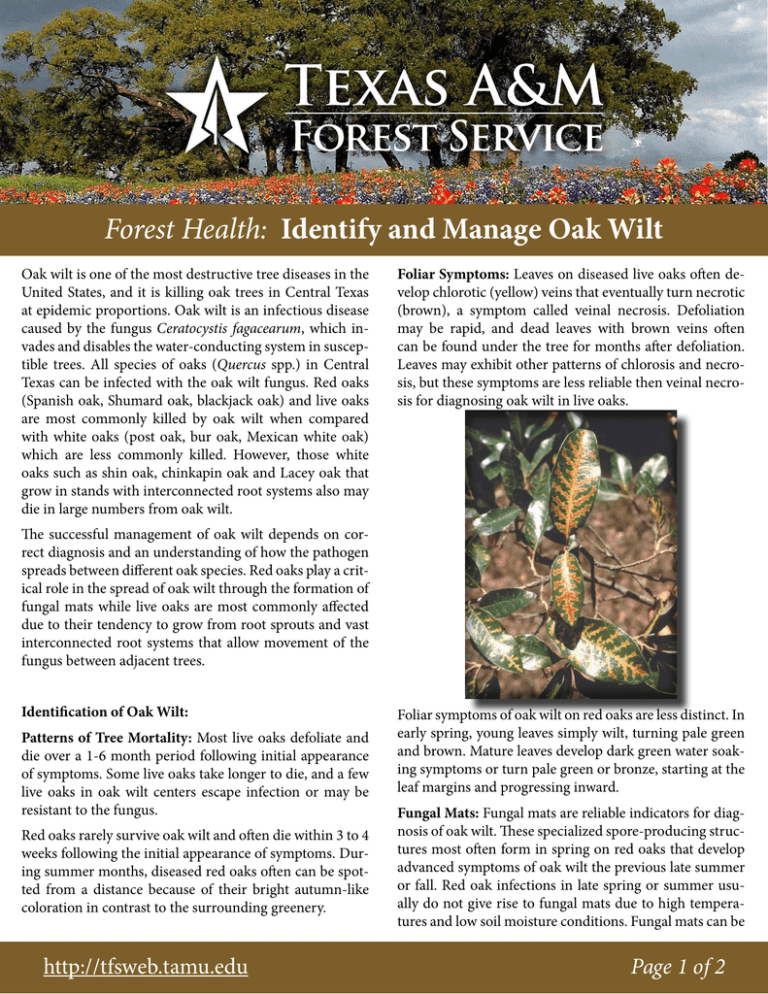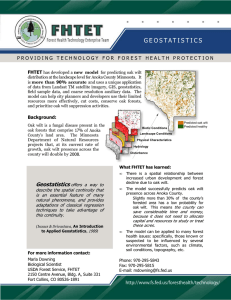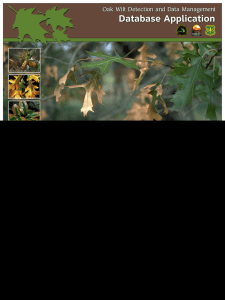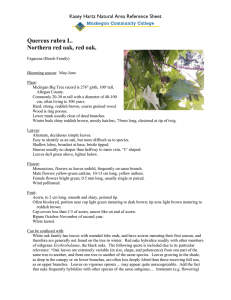Forest Health:
advertisement

Forest Health: Identify and Manage Oak Wilt Oak wilt is one of the most destructive tree diseases in the United States, and it is killing oak trees in Central Texas at epidemic proportions. Oak wilt is an infectious disease caused by the fungus Ceratocystis fagacearum, which invades and disables the water-conducting system in susceptible trees. All species of oaks (Quercus spp.) in Central Texas can be infected with the oak wilt fungus. Red oaks (Spanish oak, Shumard oak, blackjack oak) and live oaks are most commonly killed by oak wilt when compared with white oaks (post oak, bur oak, Mexican white oak) which are less commonly killed. However, those white oaks such as shin oak, chinkapin oak and Lacey oak that grow in stands with interconnected root systems also may die in large numbers from oak wilt. Foliar Symptoms: Leaves on diseased live oaks often develop chlorotic (yellow) veins that eventually turn necrotic (brown), a symptom called veinal necrosis. Defoliation may be rapid, and dead leaves with brown veins often can be found under the tree for months after defoliation. Leaves may exhibit other patterns of chlorosis and necrosis, but these symptoms are less reliable then veinal necrosis for diagnosing oak wilt in live oaks. The successful management of oak wilt depends on correct diagnosis and an understanding of how the pathogen spreads between different oak species. Red oaks play a critical role in the spread of oak wilt through the formation of fungal mats while live oaks are most commonly affected due to their tendency to grow from root sprouts and vast interconnected root systems that allow movement of the fungus between adjacent trees. Identification of Oak Wilt: Patterns of Tree Mortality: Most live oaks defoliate and die over a 1-6 month period following initial appearance of symptoms. Some live oaks take longer to die, and a few live oaks in oak wilt centers escape infection or may be resistant to the fungus. Red oaks rarely survive oak wilt and often die within 3 to 4 weeks following the initial appearance of symptoms. During summer months, diseased red oaks often can be spotted from a distance because of their bright autumn-like coloration in contrast to the surrounding greenery. http://tfsweb.tamu.edu Foliar symptoms of oak wilt on red oaks are less distinct. In early spring, young leaves simply wilt, turning pale green and brown. Mature leaves develop dark green water soaking symptoms or turn pale green or bronze, starting at the leaf margins and progressing inward. Fungal Mats: Fungal mats are reliable indicators for diagnosis of oak wilt. These specialized spore-producing structures most often form in spring on red oaks that develop advanced symptoms of oak wilt the previous late summer or fall. Red oak infections in late spring or summer usually do not give rise to fungal mats due to high temperatures and low soil moisture conditions. Fungal mats can be Page 1 of 2 Forest Health: Identify and Manage Oak Wilt found by looking for inconspicuous narrow cracks in the bark of dying red oaks leading to hollow areas between the bark and wood. They often have a distinctive odor similar to fermenting fruit. Fungal mats can be exposed for inspection by chopping away the loose bark. Fungal mats do not form on infected live oaks or white oaks. Prevent New Infections • Cut and dispose of diseased red oaks immediately. • Avoid wounding oak trees, including pruning, from February through June, and paint all wounds and fresh stumps regardless of season. • Handle oak firewood cautiously, burn all firewood before spring, and never store unseasoned oak wood from infected trees near healthy oaks. • Cover unseasoned firewood (from infection centers and unknown origins) with clear plastic, and bury the edges of the plastic. Stop Spread through Roots • Install a trench at least 4 ft deep and 100 ft beyond the perimeter of infection centers to break up root connections. • Cut or uproot all trees within the 100-ft barrier (except those injected with fungicide). Laboratory Diagnosis: Oak wilt diagnosis may be confirmed by isolating the fungus from diseased tissues in the laboratory. Samples can be submitted to: Texas Plant Disease Diagnostic Laboratory, 1500 Research Parkway, Suite A130, Texas A&M University Research Park, College Station, TX 77845. A Texas A&M Forest Service forester, a county extension agent or trained arborist should be consulted for proper collection and submission of samples. Integrated Oak Wilt Management: Early detection and prompt action are essential for successful management of oak wilt. The specific measures taken depend on several circumstances outlined in this fact sheet, but should include appropriate combinations of the following: http://tfsweb.tamu.edu Inject High-Value Oaks with Fungicide • Identify high-value oak trees in close proximity to expanding oak wilt infection centers. • Consult a trained and licensed arborist (with certified applicator’s license) for treatment of high-value oak trees with injections of the fungicide propiconazole. Plant New Trees • Promote biological diversity in the landscape by planting less-common native trees. • Avoid wounding oaks during planting. For more information on oak wilt in Texas, visit the internet website www.texasoakwilt.org. Page 2 of 2



